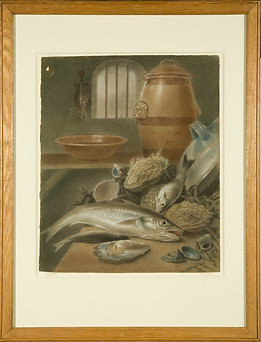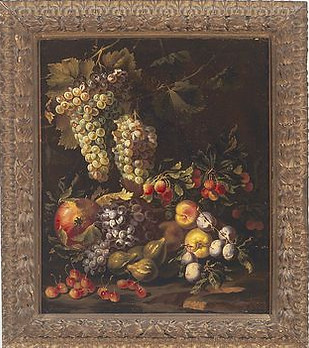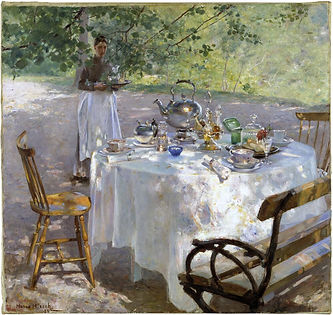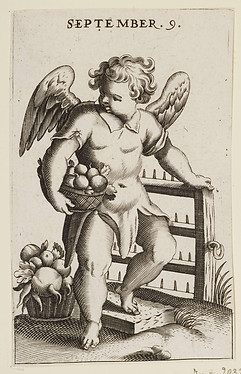
Exhibition Arcangeli
Young curator: Art & Food in the Centuries
The students of IsArt, Liceo Artistico Arcangeli in Bologna, who participated in the CrowdSchool Project, chose a series of paintings and objects, taken from the Europeana collections, with which they created a small exhibition on the theme of food in art, which we present on this page, adding their comments on the selected works.
In a gloomy painting, made in oil on canvas and entitled "Still Life", Pehr Hillestrom depicts a dinner in the foreground. On this laid table there are some foods and dishes that are used in daily life. Bread, cucumbers, eggs, spinach, roast chicken: good food accompanied by a good red wine. It is the perfect representation of a full meal. (Sara Serra)

In this composition by O.D. Ottesen, oil on canvas dated 1851, on a table covered with a purple tablecloth and invaded by ivy, we see in the centre a cut melon, with various types of fruit and vegetables around it: sour-sugary (apples, pears, plums, grapes, apricots, cherries, melon); sugary (figs); oily / dry (dates); two vegetables (tomato and mushroom) and the plants that derive from the fruits. There are also three insects: a beetle, a bee and a snail. (Elisa Barducci)

In this painting, visible at the Bristol Museums, Galleries & Archives, we observe the interior of a food shop specializing in fish. Above the table, we see three utensils: a bowl, a wooden vase and a metal lid. There are also three fish, various seafood and clams with the remains of algae attached. A fish hangs on the walls near the window. (Elisa Barducci)

The statuette, taken from a series of "Wiener Kaufufe", represents a seller of vegetables. The work rests on a white base with golden wavy tendrils and brightly painted plastic flowers. The woman holds a basket with vegetables on her right arm and wears a yellow jacket over a white blouse and a red floral bodice, a white scarf with a blue pattern, a black apron over a white skirt painted in purple and green and yellow shoes. The hems of her robe are gilded. In the 18th century, the servants were tasked with taking everything needed for fresh food and drinks to the market every day, but the Viennese waitresses were not dressed as well and elegantly as the artist portrays them in this porcelain. The woman is represented in an elegant and graceful appearance, which makes her appear more lady than she serves her. (Elisa Barducci)

I interpreted this painting as the "Last Supper", but in this case the table is round and not rectangular. The room in which the scene is set presents an essential architecture, with three openings on the back, in which a hint of a Flemish-like landscape can be glimpsed. (Indiana Crismari)

In this still life we can observe a pork and chicken roast. The colours are very sad, as indeed the whole work. The background is very dark and brown in colour. On the edge of the plate there is a slice of lemon and next to it we can see some oak leaves. This leaf is a symbol of strength and the oak is the king of trees, revered since ancient times as a symbol of strength, audacity and longevity. The oak leaf is dedicated to people who are courageous, noble, independent and with their feet firmly on the ground. In this way, the author wanted to express the strength and anguish of life. (Indiana Crismari)

In this work we can see Eve, completely naked, holding a red apple in her left hand and a branch with six leaves in her right. Her hair is red, curly and long. In the left corner we can see the snake coiled on an apple tree. The snake is also a symbol of sexuality and is considered a magical animal due to the characteristic it has of changing its skin, thus renewing its appearance. (Indiana Crismari)

This dish of Baroque origin was made and painted by hand. The Baroque Decor is a unique, rich decoration that is inspired by and recalls the glories of the Baroque period (17th century). The Maison Versace was also inspired by this decoration for its famous collection of high fashion clothes. (Indiana Crismari)

On the right of this painting we see a naked woman sitting on top of blankets and various types of fruit at her feet, while on the left of her an elderly person with a cane is presented. The only difference is that the old woman is fully clothed with only her feet bare, while the girl is completely naked. (Indiana Crismari)

The woman shown on the right has a light and delicate complexion. She is completely naked and is lying on a red blanket, like her hair. On the left of the painting we can see an elderly lady who is talking to her, while in the right corner next to the woman's body there are apples and grapes. (Indiana Crismari)

The face of the woman pictured here looks like that of a teenager. Her gaze is pointed down and her expression is sweet and she seems absorbed in melancholy thoughts. Her hair is tied up and she has a kind of straw hat on her head. In her left hand she holds a red apple. (Indiana Crismari)

Still life is an artistic genre that consists of the pictorial representation of inanimate objects, such as flowers, fruit, vegetables, musical instruments, bottles or dead animals. In fact, in this work we can see different types of fruit such as pomegranate, grapes, figs and many others. (Indiana Crismari)

The painting depicts a woman, probably the mother, together with a man, father, and another young woman, around a table sipping tea. Also, there is a dog on a stool next to her mother. (Alice Matteuzzi)

This work, painted by Wijnen Oswald, represents a still life, made up of fruit and vegetables, and decorated with flowers and butterflies. Among the vegetables we can identify: a pomegranate, peaches, black and green grapes, a melon, currants. On a stylistic level, crowding prevails, harmonized by colours. The light comes from the top left. The background is neutral. (Alice Matteuzzi)

The work, entitled "Tobacco Pipe and Drinking Utensils" by Jean Simeon Chardin, is an oil painting on canvas, and depicts a stage of preparation for painting. The composition is represented above a table: in the centre a brown case in foreshortening, containing some bottles that could be tempera. In front of the case we find a carafe and a container next to its lid. On the left we find a glass bottle and a glass, both separated by a long brush that touches the bottles in the case, while on the right a goblet is represented with a white cloth inside and a painting tool placed on the table. The lighting comes from the left and features the use of cold and gloomy tones, as can be seen from the choice of colours. (Alice Matteuzzi)

In this Impressionist-style work by Hanna Hirsch-Pauli, dated 1887, breakfast takes place outdoors. In the background, the fronds of the trees light up in various shades of green thanks to a light that alludes to the advanced morning time in which the scene is taking place. In the foreground, a round table wrapped in a very light white tablecloth supports an entire breakfast service. We can in fact recognize a teapot, glasses, plates, crockery, napkins, cups and mugs, glass containers. Around the table there are two chairs and a bench, while in the upper left, mirroring the observer, a young girl is intent on bringing a tray to the table. The scene in the foreground takes place under a light partially filtered by a tree, which generates a penumbra capable of creating a very immersive atmosphere. (Matteo Mobrici)

This work was created by Maerten Boelema de Stomme, a Dutch artist born in 1611. The painting, made with oil on canvas, represents a still life composed of food and kitchen furniture items such as jug and glasses. (Ilaria Magrin)

This work was made by Jan Davidsz de Heem, a Dutch artist born in 1606 who painted mainly still life paintings and portraits. The work represents a still life composed of several elements which many foods, such as fruits and vegetables, or sea foods, such as a crab on the right. (Ilaria Magrin)

This work is an illustration made by Hans Simon Holtzbecker, a German artist born in 1610 in Hamburg. In this illustration, probably made for an herbarium, various qualities of tomatoes, yellow and red, are represented. The work is made in pencil. (Ilaria Magrin)

Jean-Baptiste-Siméon Chardin was a painter of French origin of the first half of the 18th century. During his life, the artist mainly created still life, miniatures and genre paintings, after having studied in some workshops of various minor artists, even if his preference was certainly aimed at observing the truth. The artist's last years were marked by a serious eye disease that no longer allowed him to work in oil, but only with pastels, proving to be skilled in making portraits and self-portraits. In this work called, "Still life with Cat and Fish", we can see the representation of a still life with predominantly dark tones; it was made in oil around 1728. The composition appears well structured, consisting of a cat that wanders around some fish ready to be cooked, on the right we can also see a small head of garlic and a mortar in which it will probably be pounded. (Ilaria Magrin)

The image portrays the story of Adam and Eve, the biblical story in which Eve is persuaded by Satan to eat the forbidden fruit of a tree. However, in this artwork, it appears that it is actually Adam who is giving an apple to Eve. The fruit symbolizes sin. In the work, two people eating are seen in the foreground, with three fruit trees in the background. (Emma Ricci)

This fresco depicts a centaur handing a basket of fruit to a woman, probably a goddess. The woman is surrounded by other characters who admire her. (Lavinia Camoletti)

In this work, the red-haired girl with a simple white dressing gown immediately catches the eye, in the action of picking fruit from a tree. The woman has placed the fruits in the baskets placed on the ground next to her and, always near her there is also a dog. The background is characterized by a hilly landscape where you can glimpse a castle, on the horizon we observe a brightly coloured sunset. The work is two-dimensional, there is the presence of chiaroscuro which gives the work a slight depth. For some elements there is also the presence of three-dimensionality, for example in the baskets. (Stella Gega)

In this work we immediately notice on our right a fruit seller wearing a red and blue dress as she hands a man a fig. The girl is surrounded by baskets of fruit and vegetables that are placed both on a table and on the ground. Under the table we can see a monkey taking a pear from a basket. Instead above the table we see a series of birds resting on fruit and a parrot flying over the table, these details suggest that this place is set in an exotic place, as is also confirmed in the various baskets of some tropical fruits. The work has bright colours and an accentuated chiaroscuro that gives the work three-dimensionality. (Stella Gega)

In this painting by Gerard Seghers the Last Supper is represented, or the biblical episode in which Christ gathers to dinner with his twelve apostles. As you can see, almost none of the apostles look at Jesus, except the two to his left. Christ is also depicted with his gaze turned upwards, with bread in his hands. The setting is not clear, as there are no precise references. In the background we see a drapery, which covers it almost entirely, except for a small window from which you can see the sky. The table is not richly set. In fact there are only the dish in the centre of the table, the loaves of bread, plates and glasses. On the left side of the work there is an amphora, probably containing water, and a basket with bread. (Giorgia Tonelli)

This print depicts a putto standing, holding a basket of fruit, probably fruit and vegetables typical of September, as the name of the month is written above the image. Another fruit basket is placed at the foot of the little angel. In the background we see a probable campaign tool. (Giorgia Tonelli)

In this work two still life's are depicted that take human form, representing two seasons: spring and summer. In the depiction of spring, the human half-length is mainly made up of leaves and flowers, while that of summer is made up of fruit and vegetables. This is a print and recalls the works of Arcimboldo. (Giorgia Tonelli)

The work is titled "A girl with fruits in a basket" by Constantin Hansen. The main subject of the painting is a half-length girl with a basket of fruit in her hand. She is wearing a dress of a rather dull dark purple, while on her head she wears a straw hat with a white ribbon and two pink laces. She has a very pale pink complexion and a pouting face. She is represented on a dark background. Finally, the light comes from the top right and hits the girl from the side. (Martina Tracchi)

This work is the representation of a still life that contains various elements of natural origin within a gloomy scene, but rich in colours, where the light does a job of highlighting the elements in the foreground. On a wooden table there are many types of fruit and vegetables as if they were being prepared to be displayed by a fruit seller. (Giulia Gargani)

This work represents a laden table, with a crumpled tablecloth positioned almost at the end of the top as if it were about to fall, supported only by a few plates. The dishes contain remnants of food, partly cut meat, while another dish contains a lemon whose peel is partly peeled. These characteristics suggest that the end of a meal was represented. It is an elegant and detailed still life, which presents particularly accurate plays of light. (Federica Chiarini)

Looking at this painting you can see various types of fruit and even a lobster. Unlike other paintings, this one is much more colourful and the colours are much brighter. (Virginia Zambelli)

In the centre of the painting there are fish in a basket. The fish are covered with cuts. To the right are fish cut with blood still on. At the bottom left we can see an overturned crab and mussels. All these elements are placed on top of a table. (Virginia Zambelli)

Looking at this painting it can be seen that in the centre there is a large bunch of grapes. It is a painting full of fruit and on the right you can see a gold coloured statuette holding an orange. Many colours are used in this painting too. (Virginia Zambelli)

Looking at this painting one might think of a dinner that has not yet begun. Very dark colours are used but the first thing you notice is the table with the food. (Virginia Zambelli)


This blue and white coloured plate features paintings of horses in an abstract grassland, with flowers and leaves drawn to fill in the background. The representations are placed in a geometric way, with a leaf in the centre and around three horses depicted in the act of movement. The style is a bit oriental. (Viola Marshall)
The work represents a woman who sells vegetables, fruit and roots, the woman has her hair tied up and a white silk shirt, light skin and an ochre yellow corset over a skirt in shades of dark blue and entirely surrounded by flat baskets. and cans of fruit and vegetables, except behind where you can glimpse a landscape as wide as it is. In the background, on the left, a young man has climbed the branches of a leafy tree to pick its fruits, while on the ground a woman collects other fruits found on the ground. On the right the landscape extends until it gets lost in a village at the foot of mountains covered by a veil of fog. The painter organizes the space in a precise way: he enhances the surfaces of the vegetables flaunting a contagious and immediate pleasure. (Stella Longhi)

The work features a glass goblet, for wine or water, most likely used in baroque banquets. It is almost certainly in blown glass, coloured with white tempera and with abstract decorations in black, which create a nice contrast. (Niccolò Salani)

The work represents a rich dinner between noble lords, who is also present with a servant. The table is richly laid, the work is adorned with bright colours, the perspective is wrong and intuitive, but in any case the work is able to best represent a court environment. (Amedeo Montanaro)

A beautiful landscape painted with great precision. It represents a village in a tropical area, as can be deduced from the fact that there is a palm grove. The ground is sandy and people's clothes are extremely colourful. (Anna Ortolani)

This painting shows some vegetables in the foreground, while behind the trees you can see a countryside view with a small house. The owner is probably the farmer on the left of the painting, leaning against a rock with a stick in his hands. In the foreground there are many vegetables including pumpkins of various kinds, an artichoke plant and cabbage. The atmosphere is very relaxing and is reminiscent of an autumn evening. The brushstrokes were given with great precision. (Anna Ortolani)

In this painting there are a great variety of game and fruit, inside decorated vases. In the foreground, the hare immediately catches the eye, alongside a partridge, a wild bird that lives mainly in the mountains. You can also see a very colourful bird, a kingfisher, and finally a turtle dove. Fruits and vegetables are very varied. Above the hare there is a vase full of raspberries and next to them asparagus and an artichoke, while to the right of the painting another vase with lots of fruit. (Anna Ortolani)

A large variety of fish, crustaceans, and molluscs are featured in this painting, including a hanging squid, anchovies, and a cluster of mussels. A lobster and a crab are inside a yellow colander. At the bottom right there are also two fish from the Mediterranean named garfish. This makes us understand that this cuisine probably comes from a Mediterranean house. (Anna Ortolani)

The picture presents a peasant family gathered around a table in the evening. Hanging from the ceiling is a lantern that gives off a dim light, which illuminates the faces of the subjects and the food on the table. The faces of the peasants are shown as grotesque and tried by fatigue, with gnarled hands, details that make us understand the weight of the efforts faced during the day. (Zoe Rimondi)

Made around 1622 by the Dutch painter Isaac Isaacsz (1598-1649), "A Feast" is an extremely immersive oil on canvas: the scene is set in a festive context, animated by the presence of numerous characters elegantly dressed and intent on feasting. The climate is typically baroque and the story is structured on a perspective, almost photographic glimpse, in an attempt to make the work more inclusive. (Lorenzo Gambardella)

